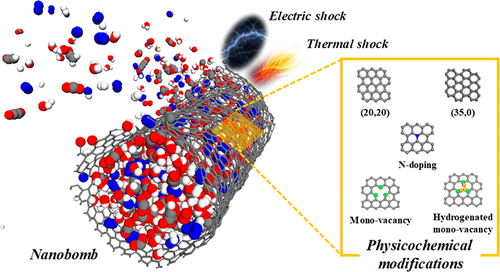当前位置:
X-MOL 学术
›
J. Phys. Chem. C
›
论文详情
Our official English website, www.x-mol.net, welcomes your
feedback! (Note: you will need to create a separate account there.)
Controllable Explosion of Nanobomb by Modifying Nanocontainer and External Shocks
The Journal of Physical Chemistry C ( IF 3.3 ) Pub Date : 2020-01-27 , DOI: 10.1021/acs.jpcc.9b09140 Woo Cheol Jeon 1 , Jeong Hyeon Lee 1 , Jin Chul Kim 1 , Sang-Hyun Jung 2 , Soo Gyeong Cho 2 , Sang Kyu Kwak 1
The Journal of Physical Chemistry C ( IF 3.3 ) Pub Date : 2020-01-27 , DOI: 10.1021/acs.jpcc.9b09140 Woo Cheol Jeon 1 , Jeong Hyeon Lee 1 , Jin Chul Kim 1 , Sang-Hyun Jung 2 , Soo Gyeong Cho 2 , Sang Kyu Kwak 1
Affiliation

|
The effects of physicochemical modification of carbon nanotubes (CNTs) on the explosion dynamics of a nanobomb, comprising nitromethane confined in CNTs, were investigated using nonequilibrium reactive molecular dynamics and density functional theory (DFT) calculations. CNTs with chirality, nitrogen-doping, and monovacancy defect were utilized. All modifications commonly reduced the time for nanobomb bursting under thermal shock and led to an overall similar reaction pathway. Bursting time of chirality-modified nanobomb was shortened by inferior mechanical property, whereas nitrogen-doping and monovacancy modification reduced the time by increased chemical reactivity (i.e., facilitated attachment of reaction intermediates to the nanocontainer). DFT calculations showed that nitrogen-doping and introducing monovacancy defects lowered the activation energy and heat of formation of the Stone–Wales defects and induced high binding energy of the intermediates, whereas chirality modification alone was ineffective. In addition, decomposition of the nanobomb was initiated via another two heating methods (i.e., electric spark and electromagnetic induction). Under a continuous electric field, bursting of nanobomb with electromagnetic induction was much faster due to oscillating frequency. This theoretical exploration of the effects of physicochemical modification of the nanocontainer and the explosion-initiation methods on the explosion of nanobombs provides in-depth understanding of a confined nanostructured high-energy material.
中文翻译:

通过改变纳米容器和外部冲击可控地爆炸纳米炸弹
使用非平衡反应性分子动力学和密度泛函理论(DFT)计算研究了碳纳米管(CNT)的物理化学修饰对包含在CNT中的硝基甲烷的纳米炸弹爆炸动力学的影响。利用具有手性,氮掺杂和单空位缺陷的CNT。所有修改通常减少了在热冲击下纳米炸弹爆炸的时间,并导致了总体上相似的反应路径。较差的机械性能缩短了手性改性纳米炸弹的破裂时间,而氮掺杂和单空位改性则通过增加化学反应性(即,促进了反应中间体与纳米容器的附着)而缩短了时间。DFT计算表明,氮掺杂和引入单空位缺陷降低了Stone-Wales缺陷形成的活化能和形成热,并诱导了中间体的高结合能,而仅手性修饰无效。此外,纳米炸弹的分解是通过另外两种加热方法(即电火花和电磁感应)引发的。在连续的电场下,由于振荡频率的原因,具有电磁感应的纳米炸弹爆炸要快得多。对纳米容器的物理化学修饰和爆炸引发方法对纳米炸弹爆炸的影响的理论探索提供了对有限的纳米结构高能材料的深入了解。
更新日期:2020-01-27
中文翻译:

通过改变纳米容器和外部冲击可控地爆炸纳米炸弹
使用非平衡反应性分子动力学和密度泛函理论(DFT)计算研究了碳纳米管(CNT)的物理化学修饰对包含在CNT中的硝基甲烷的纳米炸弹爆炸动力学的影响。利用具有手性,氮掺杂和单空位缺陷的CNT。所有修改通常减少了在热冲击下纳米炸弹爆炸的时间,并导致了总体上相似的反应路径。较差的机械性能缩短了手性改性纳米炸弹的破裂时间,而氮掺杂和单空位改性则通过增加化学反应性(即,促进了反应中间体与纳米容器的附着)而缩短了时间。DFT计算表明,氮掺杂和引入单空位缺陷降低了Stone-Wales缺陷形成的活化能和形成热,并诱导了中间体的高结合能,而仅手性修饰无效。此外,纳米炸弹的分解是通过另外两种加热方法(即电火花和电磁感应)引发的。在连续的电场下,由于振荡频率的原因,具有电磁感应的纳米炸弹爆炸要快得多。对纳米容器的物理化学修饰和爆炸引发方法对纳米炸弹爆炸的影响的理论探索提供了对有限的纳米结构高能材料的深入了解。











































 京公网安备 11010802027423号
京公网安备 11010802027423号